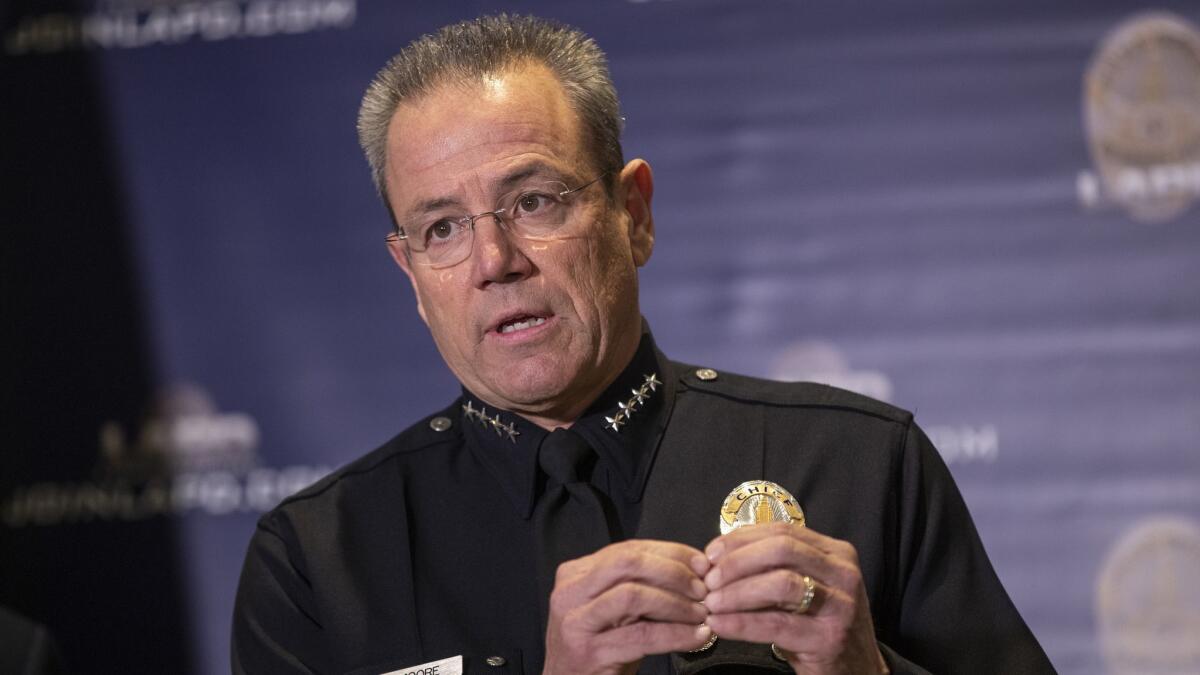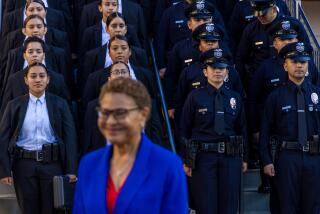Editorial: Ghosts of Rampart are hovering over LAPD’s latest gang scandal

- Share via
Do not minimize the gravity of the Los Angeles Police Department’s data falsification probe. The suspicion that police officers in the Metro Division filed deceitful reports about people they stopped and interviewed raises serious concerns of police corruption of the highest order.
The situation brings to mind the disastrous Rampart scandal of the late 1990s, in which police framed civilians and falsified testimony in reports and on the witness stand. The trouble ultimately led to a federal consent decree and court oversight of the department.
It is true that there are not currently any Rampart-style allegations that officers falsely accused innocent people of committing crimes. But asserting that Angelenos are gang members when they are not can have serious repercussions. When one’s name is entered into a gang database, it creates a quasi-criminal cloud that can follow that person for the rest of his or her life. The gang connection, even if false, could affect future criminal proceedings, undermine plea bargains, enhance sentences and sharply limit educational and employment opportunities. It can affect the target’s entire family and, indeed, community.
Dishonesty in policing strikes at the heart of community trust in law enforcement. The allegations validate widespread concerns, especially in African American and Latino communities where police anti-gang activity is most intense, that police are there not to protect the community but to occupy it and harass the innocent along with the guilty.
The LAPD has tried desperately to rebuild trust in those communities. The current allegations do not help.
Those allegations began to emerge, as The Times reported in a series of stories beginning Jan. 6, after a San Fernando Valley mother received notification from the LAPD last year that her son had been identified as a gang member. She said the department was mistaken, and brought her concern to police personnel. An investigation ensued, and that led to a criminal probe.
There is a bright side. Thank goodness for the mother who reported her concerns. Many parents might have chosen not to raise the issue out of fear of retaliation or, at least, official inaction.
And thank goodness that the police supervisor who heard the complaint took it seriously and checked the body camera footage of the officers involved. The video contradicted the gang association that the officer asserted on the card.
That’s a major difference from the Rampart era: body-worn cameras, the mandate by the LAPD (and now the state) that officers use them, and the internal procedures that make the video available for review. Video from body-worn cameras has proven a valuable tool to ward off false complaints by civilians of police misconduct, but in this case it may prove to be essential in ferreting out corruption.
Chief Michel Moore and the Police Commission appear to be taking the situation seriously, as they should. The LAPD’s oversight and accountability structure will be tested.
The investigation, if it is done properly, must go beyond the question of which officers did what and to whom, which criminal prosecutions have been tainted and what discipline and criminal sanctions should be administered.
The public needs to hear from Moore and the department just how this happened, and why. The Times reported that that Metro officers feel pressure to produce numbers that show they are effective at targeting gangs and weapons. It may be that a demand for numbers drove officers to fake their reports.
If that’s the case, of course it would not excuse officers from lying. But it should cause a reconsideration of the LAPD’s dual — almost two-faced — policing culture.
The LAPD in recent years has enhanced its community-based policing efforts by expanding Community Safety Partnerships — a program that built trust between police and residents of public housing developments — to encompass entire neighborhoods. Better trust has led to higher clearance rates for previously unsolved crimes. It has helped drive down serious crime numbers and make public spaces, previously unsafe, more widely available to residents.
The Metro Division has a different culture. Often termed the department’s elite unit, the division is often deployed to areas that experience crime spikes. It is known for a different, older style of policing — one that emphasizes car stops and searches for weapons rather than trust-building.
Moore last year directed Metro to reduce its vehicle stops following a Times investigation that showed the LAPD pulls over African American drivers at a rate more than five times their share of the city’s population, and after concluding that the program was ineffective.
It may, or may not, be possible for the department to continue a dual policing culture. But in either case, it must do a better job of calculating the costs of its choices — and of chasing away the ghosts of Rampart.
More to Read
A cure for the common opinion
Get thought-provoking perspectives with our weekly newsletter.
You may occasionally receive promotional content from the Los Angeles Times.










